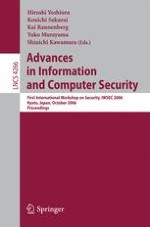ItwasourpleasuretoholdtheInternationalWorkshoponSecurity2006(IWSEC 2006) this year in Kyoto and to publish the proceedings as a volume of the Lecture Notes in Computer Science series. The workshop was our ?rst trial in that two major academic society groups on security in Japan, viz. ISEC and CSEC, jointly organized it; ISEC is a te- nical group on information security of the Institute of Electronics, Information and Communication Engineers (IEICE), and CSEC is a special interest group on computer security of the Information Processing Society of Japan (IPSJ). It was Ryoichi Sasaki, the former head of CSEC, who proposed holding such an international workshop in Japan for the ?rst time, two years ago. The two groups supported his idea and started organizing the workshop. CSEC has its annual domestic symposium, the Computer Security Symposium (CSS), in - tober for three days, and we decided to organize the workshop prior to CSS this year. The initial aim of the workshop was primarily to provide young researchers with the opportunity to present their work in English. However, due to more submissions than we had anticipated, the quality of the accepted papers became far better than we had expected. Theconferencereceived147submissions,outofwhichtheprogramcommittee selected 30 for presentation. These proceedings contain the ?nal versions of the accepted papers, which the authors ?nalized on the basis of comments from the reviewers. Since these revisions were not subject to editorial review, the authors bear full responsibility for the contents of their papers.
